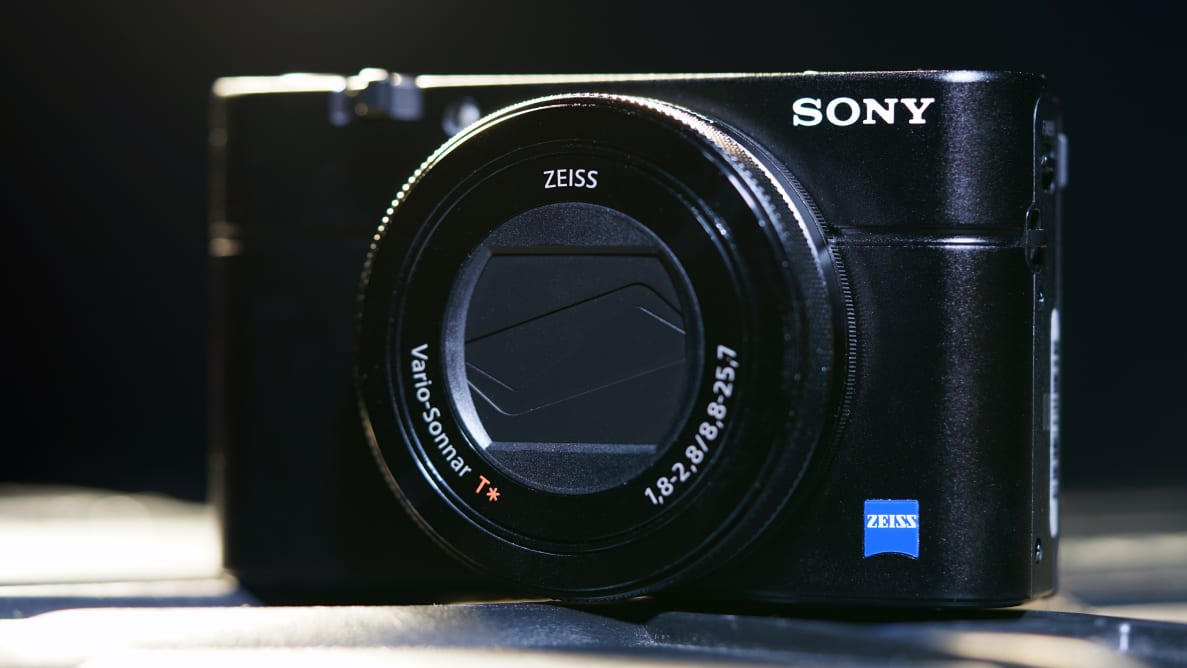Sony has raised the bar once again with the fourth installment of the series: the Sony Cyber-Shot RX100 IV (MSRP $948). The RX100 IV builds on its predecessor with a new (and slightly improved) Exmor RS stacked CMOS sensor and Bionz X processor. This enables it to capture 4K footage and faster bursts of photos, providing a hybrid capability unheard of in a pocketable camera.
Like the previous RX100s, version IV makes a strong case that it's the best point-and-shoot you can buy. The problem? Buying it costs more than ever. And with the original RX100 still on the market–often for under $500–the RX100 IV's biggest competition might just be its predecessors.
Design & Handling
I think they changed the name?
There is really only one major design change between the RX100 III and the RX100 IV: the III is now a IV. That sounds reductive, but the RX100 IV has the same compact body, same lens, same controls, and (almost) the same pop-up viewfinder as last year's model. Hey, if it ain't broke, don't fix it.
{{ photo_gallery name="Tour" }}
If you're unfamiliar with the RX100 series, the cameras are like the pocket-sized bazookas of the camera world; they pack class-leading firepower into a modest body that can fit in your shirt pocket. It doesn't have much tactility—or anything resembling a grip–but its minimal weight and small stature make that a non-issue.
As with other point-and-shoots, you can control the camera almost exclusively with one hand. Your right thumb has easy access to all your main controls: playback, trash, command dial, menu, functions, etc. There is even a dedicated record button to start capturing video easily–though it can be pressed by mistake if you're not careful.
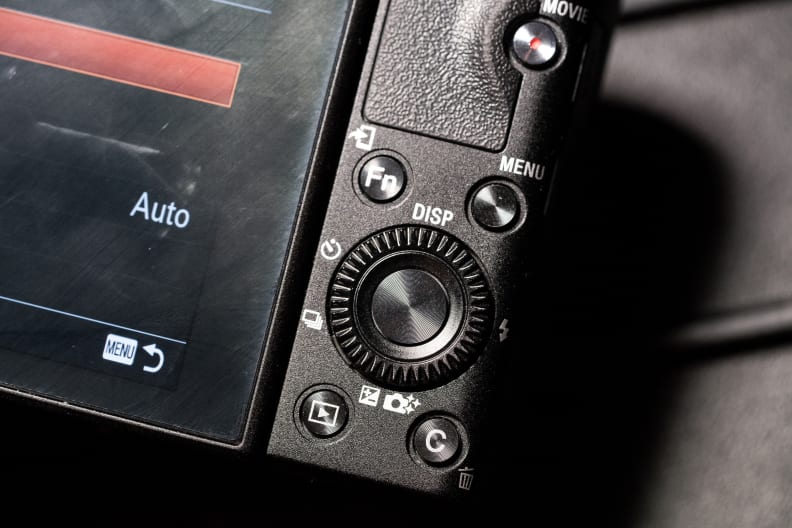
The top of the camera houses your shutter release, power button, zoom lever, and flash release. Your index finger takes care of the shutter and zooming responsibilities, while your thumb can effortlessly switch shooting modes or release the flash. As with previous RX100s, you have the luxury of using the control ring mounted on the lens to adjust key settings like shutter speed or aperture.
As far as shooting with the RX100, there is a tilting rear monitor that is used as a viewfinder, to navigate menus, or access playback. The left side also has the release for the pop-up viewfinder, if you want a more locked-in shooting experience. I prefer using the pop-up viewfinder, but it's small, and the rear LCD is very handy for getting shots from unique angles–or the perfect selfie.
The menus are identical to many other Sony cameras, which tend to be a little confusing at first. You use the rear directional pad to navigate through six tabs that are divided up by their primary function (stills, video, playback, etc.), with several sub-tabs within each. It takes some getting used to, and more than once I found it hard to find what I was looking for.
While we'd like to see some UI improvements next time around, Sony hasn't messed with the RX100's design because it strikes a great balance between usability and portability. It's a perfect solution for someone that cares about image quality, but isn't able to lug around a large camera body for whatever reason. And I have to admit: As much as I love carrying my giant DSLRs around the city, my shoulders and back were loving the decreased workload of the RX100 IV.
Performance
The best just keeps getting better.
Ever since we got our hands on the original RX100 back in 2012, we've had nothing but great things to say about the lineup. The RX100s are usually the best compact point-and-shoots around, and the bar is raised ever so slightly with each new model.
The main improvements this time around are largely due to the new Exmor RS stacked sensor. Sony's new sensor has dynamic random-access memory (DRAM) directly attached, increasing the available buffer and helping to streamline the flow of data to the processor. According to Sony, this produces over 5x faster readout speeds than other sensor setups.
{{ photo_gallery name="Samples" fullscreen="true" }}
While the new sensor certainly improves what the camera is capable of, we didn't see much change in image quality on the still side. That's not to say the quality is bad–it's easily the best quality you'll get out of any pocketable point-and-shoot–but if you're looking to upgrade from the RX100 III for improved image quality alone, you'll end up disappointed.
Color and white balance accuracy, both of which are always iffy on point-and-shoot cameras, are fantastic on the RX100 IV. While shooting RAW is always the best route for ensuring accurate colors, you can trust this camera's auto white balance to get it right in most lighting situations.
The main improvements this time around actually come on the video side, largely thanks to the addition of 4K recording. While shooting at the highest 4K setting (100 mb/s), we observed more than twice as much fine detail as we recorded with the 1080p-only RX100 III. And thanks to the fast lens and backlit sensor, we were able to shoot in near dark settings with very little drop in quality. Video enthusiasts looking for an on-the-go 4K option should look no further.

Burst shooting also received a bump in performance, capturing a blistering 16+ frames per second while using the Speed Priority Continuous mode. These are full resolution images with a fixed exposure and focus once you start firing. With the DRAM buffer, it has excellent capacity too. We were able to grab 45 JPEGs at a shutter speed of 1/32,000s before the processor had to slow down, which should give you plenty of time to get the perfect moment.
Features
Even the features have features!
While the RX100 IV isn't very different on the outside, inside is another story. We've already covered the new sensor, 4K shooting, continuous shooting, and the electronic shutter. However, the RX100 IV doesn't stop there.
One upgrade we are very fond of is the improved electronic viewfinder (EVF). The RX100 III had a 1,400,000 dot LCD, which we found extremely useful for shooting on bright days. Sony took this a step further and upped its resolution from 1.4 million dots to 2.36 million dots, producing a more detailed image to frame with.
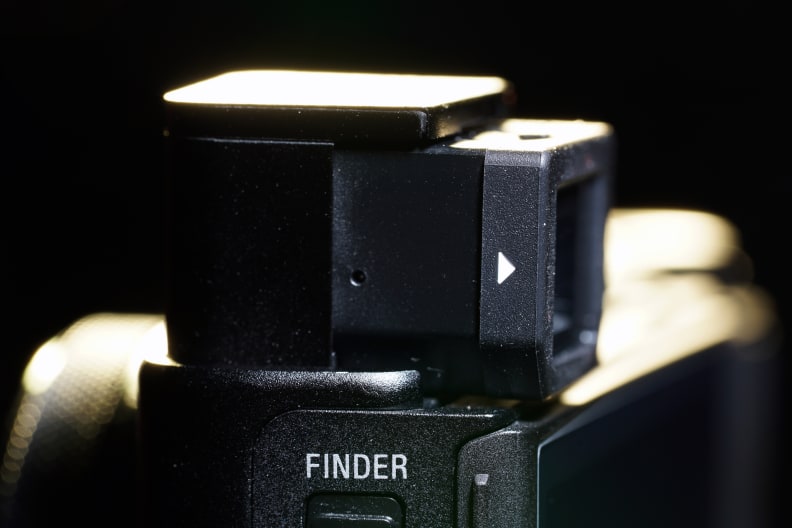
The RX100 IV has a sleek pop-up viewfinder that also powers the camera on when switched.
We still would've appreciated a touchscreen, however–especially considering the steep price tag. Touch-to-focus would improve the video functionality and solve some of the UI issues. However, with the battery life already less than stellar, we can see why Sony would leave it out.
Even without touch-to-focus, the RX100 IV has a plethora of new video features. For starters, video can now be shot with picture profiles, giving users more control of the look of their videos. You can now shoot up to 960fps for super slow motion footage. Its quality isn't great, though, as it's taken at a lower resolution and then upscaled to 1080p. And "Dual Rec" allows you to shoot 17MP still images while simultaneously recording movies.
It should be noted that to shoot the highest quality 4K (or the high frame rate video), you will need a SDXC UHS-I or II Class U3 card. You can pick one of these up for less than $50, but anything less than that will keep you shooting 1080/60p until you upgrade your card. We recommend picking up something over 64GB since a few 4K clips can fill up a card very quickly. {{amazon name="Transcend 64 GB High Speed 10 UHS-3 Flash Memory Card 95/60 MB/s (TS64GSDU3)", asin="B00J3KA814", align="right"}}
If you're someone that is already shooting video seriously, then you should be excited to know that Sony included S-Log2 gamma in this iteration. With S-Log2 gamma the image output is an ungraded, flat image that retains as much dynamic range as possible. If you aren't experienced in processing video then I would recommend steering clear of this option, because the footage really must be edited.
{{ photo_gallery name="Design" }}
Conclusion
Sony is reclaiming the pocket camera throne.
The high-end point-and-shoot market has never been more competitive. Panasonic, Canon, Nikon, Ricoh, and Sony all have skin in the game. And while Sony's RX10 series is still tops, once again Sony has condensed amazing performance down to an extremely small footprint with the latest RX100.
But while the RX100 IV might be the best pocketable camera to date, the $949 price tag is well past the point of diminishing returns. People will always want better performance and more features in a compact camera, but at what cost? When does it make more sense to just get a DSLR or mirrorless camera with an APS-C sensor and a few lenses?
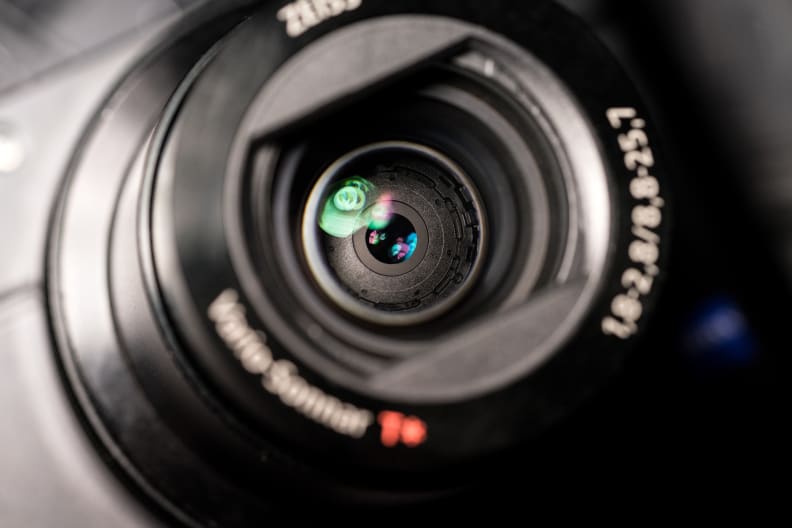
Don't get me wrong, the RX100 IV does just about everything great; it's a blue chip camera that can go with you everywhere—something you can't say about interchangeable lens cameras. But even if you need a compact camera, the RX100 IV's biggest problem might be the excellent cameras that came before it. Frankly, unless you're need 4K video or the burst mode capabilities, you'd be better off going with the RX100 III. And if you can live without an EVF then you can go one step further and and pick up the RX100 II (less than $600) or the original RX100 (less than $500) without sacrificing much.
There are other options outside of the RX100 line, as well. For more advanced photographers who don't need zoom, the Ricoh GR is an excellent choice. While you lose the amazing video features, you get a larger APS-C sensor and a lower price point.
Another strong contender is Panasonic's Lumix LX100. This is the camera that, just last year, dethroned the RX100 III as the best compact point-and-shoot on the market. It has a larger Four-thirds sensor, better viewfinder, and also offers 4K video. The RX100 IV edges it out, but not by much.
Ultimately, Sony has once again produced one of the best pocketable cameras that money can buy—it just requires a lot more money than it used to. The RX100 series is better than ever, without question. But with the price creeping toward $1,000, so is the competition.
By the Numbers
We've had a hard time finding weaknesses in the RX100s of the past and the Mark IV is no different. Building off the foundation laid by its predecessors, the newest RX100 has added Sony's new Exmor RS stacked sensor, which opens up features such as 4K and improved burst shooting.
With improved buffering enabling faster burst capture and 4K video, the RX100 IV has a resume that is nearly complete. The fact that this is a camera that can also slide into your pocket is incredible, though our lab tests did reveal that it's not quite the perfect camera.
Color & White Balance
Color accuracy on the RX100 III was legendary. It scored one of the best scores we've ever seen with a ∆C00 (saturation-corrected) error of just 1.66. That's better than almost every other camera we've ever tested, professional DSLRs included. However, Sony was still at the helm, so saturation was boosted to an absurd 120%, hurting the camera's score somewhat.
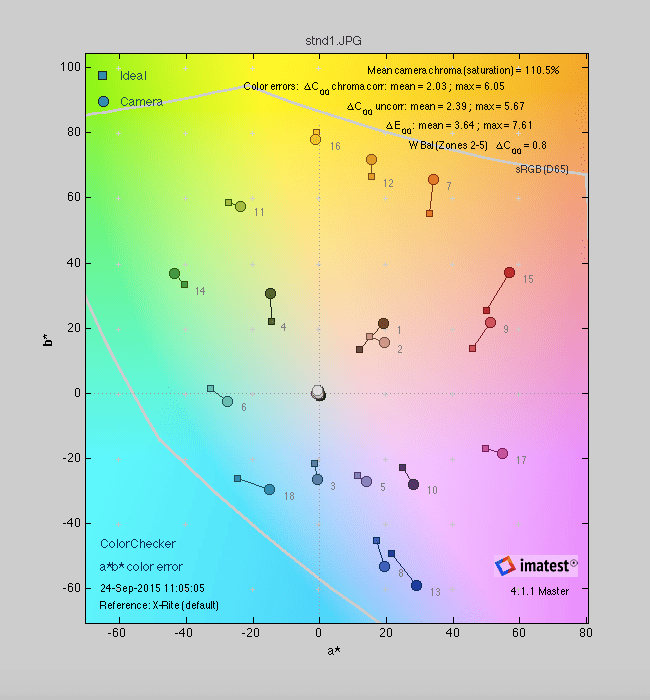
The RX100 IV has a still-respectable result, with a ∆C00 (saturation-corrected) error of 2.03. It's still near-perfect, and saturation is now a more reasonable 110% of ideal. It's a strong result, especially for a point-and-shoot.
White balance was fairly pedestrian on previous RX100s, but the Mark IV has changed that drastically. It's actually became one of the most accurate point-and-shoot white balance systems that we've tested. Auto white balance in most lighting situations–aside from incandescent) is going to get you just as close as most cameras will if you manually tune it.
Manual white balance is even more accurate with a variance of only 60 or so kelvins in all of our test condtions. Incandescent–which was the most inaccurate during auto white balance tests and notoriously hard for cameras to get correct–was the most accurate when we manually took a white balance reading.
Shooting RAW is still your best bet when it comes to color and white balance, but if you shoot JPEG or rely on the camera to do all the color work, the RX100 IV is about as good as it gets.
Sharpness
While the new Exmor RS stacked sensor brought a lot of changes to the Mark IV, it actually did very little to improve overall image sharpness—there simply isn't much room for improvement with such a compact lens. That said, the RX100 IV is still one of the sharpest pocketable cameras ever made. The combination of its lens, sensor, and processor produce images that are sharp, but not over sharpened with software–like we see with most point and shoots.
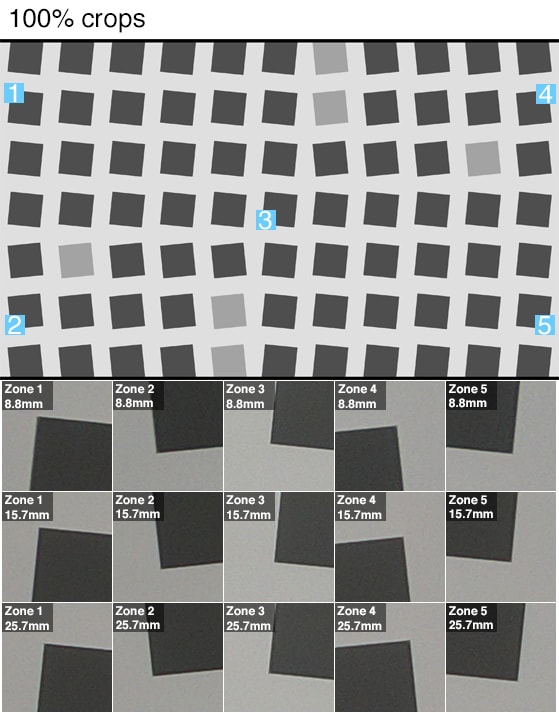
In terms of numbers, we consistently saw areas of the image produce as much as 2700 LW/PH (line widths per picture height) in the center and an overall average of 2300 LW/PH at MTF50 thanks to the software enhancement. The RAW images tend to be a little bit softer, of course, but they were still respectable if not quite on par with higher-end cameras.
Shot To Shot
The RX100 III topped out at 10 fps (frames per second) for about 15-20 shots, but the RX100 IV has the new Exmor RS stacked sensor (complete with DRAM) to help boost it further. The new sensor essentially works to lessen the bottleneck effect that typically occurs in processors when they can't keep up with the sensor. This improvement effectively doubled the amount of shots that can be taken before the camera has to stop and buffer, while also enhancing the rate of capture.
We were able to fire off shots at an impressive rate while shooting in the Speed Priority Continuous mode. The camera maxed out around 16 fps (at 1/32,000 second shutter speed) in our tests. We were able to capture up to 45 shots at once at this speed while shooting JPEG and about 20 while shooting RAW. Outside of this mode you can expect burst rates of up to 5fps, but a higher capacity as a result.
Video
While we didn't see a huge jump in still image quality this time around, the RX100 IV has pushed its video performance to another level thanks to the addition of 4K video capture.
The 4K footage you get isn't something that pro filmmakers are going to be lining up for, but it's better than almost all other point-and-shoots we've tested. Chiefly it's much sharper, as we observed an extinction resolution of around 1,400 LW/PH vertically and horizontally in both bright and low light.
The fast lens and good noise performance helped in low light conditions, resulting in hardly any quality loss at 60 lux. It can also shoot in lighting conditions as low as 1 lux and still produce an image that is well above the acceptable threshold of 50 IRE.
The only two downsides are that you need a very specific (and fairly expensive) type of SD card to shoot 4K and you can only shoot five minute clips at a time. But given that you're dropping nearly $1,000 on a point-and-shoot, you're probably willing to pony up the extra $40 for a 4K-compatible memory card.
Meet the tester
As a photojournalist, Jackson has had stints working with bands, the military, and professional baseball teams before landing with Reviewed. Outside of Reviewed, he can be found looking for the next game to relieve his "Gamer ADD" or growing his beard.
Checking our work.
Our team is here for one purpose: to help you buy the best stuff and love what you own. Our writers, editors, and lab technicians obsess over the products we cover to make sure you're confident and satisfied. Have a different opinion about something we recommend? Email us and we'll compare notes.
Shoot us an email


